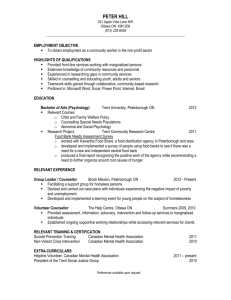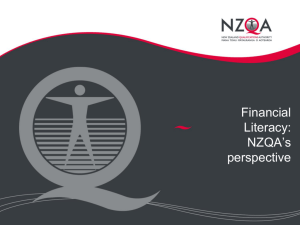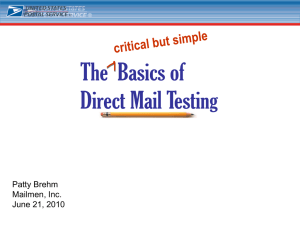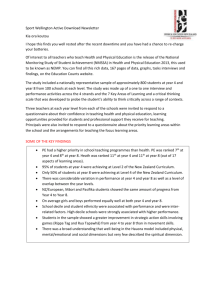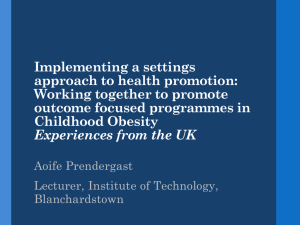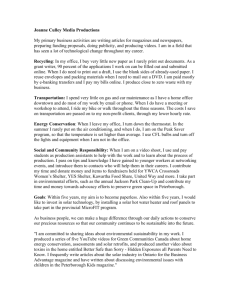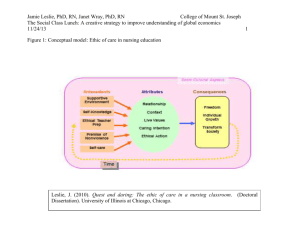Child Development and policy interventions Janet Dullaghan Head of Commissioning Child
advertisement
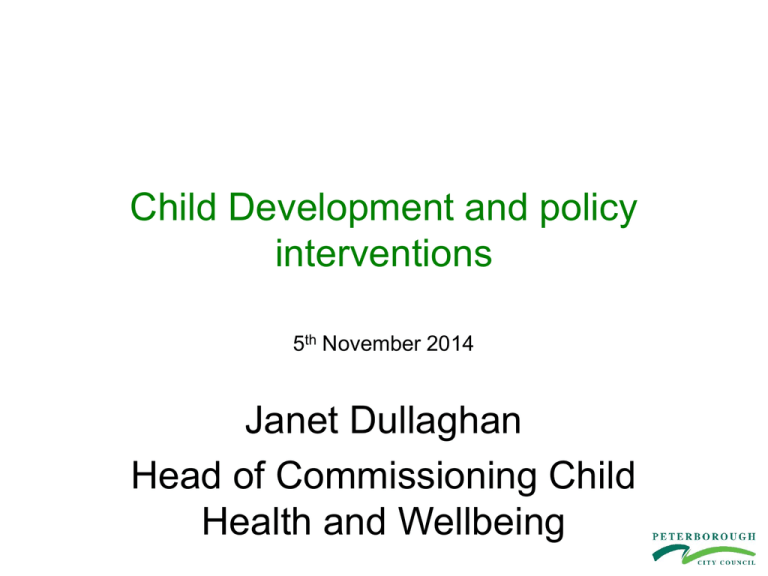
Child Development and policy interventions 5th November 2014 Janet Dullaghan Head of Commissioning Child Health and Wellbeing Context • Fastest Growing City • 24% child poverty • Growing migrant population • 17% 0 – 4 year olds in care are Eastern European Increasing numbers of children and young people who have EAL: • 135 languages now spoken in our schools • Of 1,000 new pupil admissions between October 2012 and 2013, 91% had English as an Additional Language EAL Challenge • Lower Year Group 40% EAL • 18 months ago not doing well in Phonics outcomes (year 1 test ) • EAL strategy with support for schools developed • outcome to half the attainment gap by 2016, already achieved January 2014 • Revised target to eliminate this by 2016 Peterborough has a growing and changing population People in Peterborough will be living longer over the coming decades. Between 2010 and 2031 the population of children and young people is estimated to grow by 43% that growth is not expected to be even across all ages. The population will become more diverse with increasing numbers of migrant workers. 2010 2031 % Change: 2010 to 2031 Age 0-4 10,300 17,100 24% Age 5-10 13,200 20,800 55% Age 11-15 10,800 17,000 55% Age 16-19 7,900 12,400 48% Total 0-19 44,210 69,331 43% 25000 Age Group 20000 15000 10000 5000 0 2001 Age 0-4 2010 2011 Age 5-10 2016 2021 Age 11-15 2026 2031 Age 16-19 Peterborough is not a great place to live if you are poor Peterborough has pockets of real deprivation; particularly in the central urban parts of the city. Some areas of the city are among the most deprived parts of the country; other parts are in the most affluent areas. 47% of the lower super output areas (LSOAs) in Peterborough are in the top 30% most deprived areas in England; 12.2% are in the 10% most deprived. Decile of Overall IMD Rank 2010 for the 104 Peterborough LSOA’s Indices of multiple deprivation 2010; national rank 30 25 20 15 24 10 29,654 19 13 5 12 13 7 22,547 12,875 7,734 4,893 1,448 0 Decile 1: 0- Decile 2: 10 10-20 7 7 2 Decile 3: 20-30 Decile 4: 30-40 Decile 5: 40-50 Decile 6: 50-60 Decile 7: 60-70 Decile 8: 70-80 Decile 9: 80-90 0 Decile 10: 90-100 Peterborough is not a great place to live if you are poor Children eligible for Free School Meals (FSM) is a proxy indicator for poverty statistics. Data on the educational gap between those with FSM and those without shows there is a pronounced gap in Peterborough which is wider than that of the national average. 10 5 3 Av 3 -1 2 -2 3 2 -2 4 3 -1 -2 -2 -5 -5 -10 -9 -11 -13 -12 -11 -12 -14 -15 -20 3 2 -18 -19 -14 -18 -19 -19 -22 -23 -25 -30 -35 -40 -40 -45 KS1 Reading KS1 Writing England non-FSM KS1 Maths KS2 English England FSM KS2 Maths KS2 Eng & maths Peterborough non-FSM Av = England average for all pupils GCSE 5 A*-C inc EM Peterborough FSM GCSE 5 A*-C Achievement Gap… % Difference in Pupils Achieving 5 or more GCSE A*-C including English & Maths in 2013 All Pupils -4 Free School Meals -7 English as First Language -1 English not as First Language -13 White Other -16 Asian Pakistani -8 Drivers for Change • May 2010 the Government policy regarding early years shifted to provide parents with a range of early years support and a more targeted approach. • This was reflected in the Government no longer giving the council a specific pot of money to pay for children’s centres nor provides any funding for new ones. • New funding streams include:– Funded two year old childcare for families in need – Universal funded 15 hour provision for families with 3 and 4 year olds – Funding to support the most troubled families – Growth in health visiting services – Family Nurse Partnership – Public Health Healthy Child Programme – Increased pupil premiums in schools to support vulnerable children – School funding for before and afterschool activities Our Vision For Children and Families Every child or young person is healthy, achieves their learning potential and is well equipped to go onto further learning or work • Families are strong and independent, and provide the best possible start for children and young people • Child poverty is reduced and the link between disadvantage and poorer outcomes is broken • Vulnerable families receive early support • Children and young people are safe at home and in their communities • Families stay together where possible, with the right children in care at the right time Our Approaches • • • • • Quality improvement support to child care providers CAF/MASG – Coordinated assessment and intervention process Early years integrated pathway – Healthy child programme – Increased health visitors – Connecting mums – Family Nurse Partnership – Quality child care – Children’s Centres in areas of greatest need Children with disabilities – Direct payments/personal budgets – Increase in short breaks – Education Care and health plans – Local Offer CAMH’S – Increase in Tier 2 • Behaviour support service • CPN service in schools Building Community Capacity - Being Relevant and Meaningful to Communities, Commissioners and Providers Community capacity building should: • reflect the values of community development • be driven by the community’s priorities • take the existing strengths and talents within communities as the starting point for development • be of benefit to the individuals directly involved and to their own wider community • empower people to act on behalf of their community • learn from best practice in other communities • establish and strengthen new and existing networks ‘No society has the money to buy, at market prices, what it takes to raise children, make a neighbourhood safe, care for the elderly, make democracy work or address systemic injustices... The only way the world is going to address social problems is by enlisting the very people who are now classified as ‘clients’ and ‘consumers’ and converting them into co-workers, partners and rebuilders of the core economy.’ Edgar Cahn – Developer of time-bank concept
